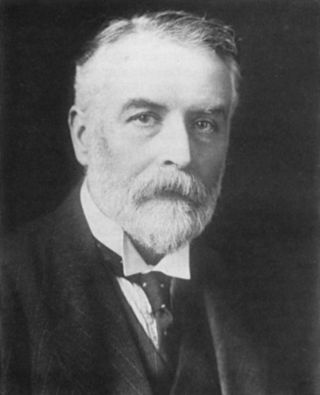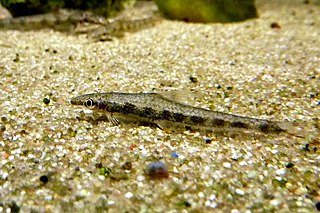Francis Buchanan, later known as Francis Hamilton but often referred to as Francis Buchanan-Hamilton, was a Scottish surgeon, surveyor and botanist who made significant contributions as a geographer and zoologist while living in India. He did not assume the name of Hamilton until three years after his retirement from India.

George Albert Boulenger was a Belgian-British zoologist who described and gave scientific names to over 2,000 new animal species, chiefly fish, reptiles, and amphibians. Boulenger was also an active botanist during the last 30 years of his life, especially in the study of roses.

Léon Louis Vaillant was a French zoologist. He is most famous for his work in the areas of herpetology, malacology, and ichthyology.
Victor Gruschka Springer was an American biologist who was a Senior Scientist emeritus, Division of Fishes at the Smithsonian Institution's National Museum of Natural History in Washington, D.C. He was a specialist in the anatomy, classification, and distribution of fishes, with a special interest in tropical marine shorefishes. He published numerous scientific studies on these subjects; also, a popular book called "Sharks in Question, the Smithsonian Answer Book" 1989.
Gilbert Percy Whitley was a British-born Australian ichthyologist and malacologist who was Curator of Fishes at the Australian Museum in Sydney for about 40 years. He was born at Swaythling, Southampton, England, and was educated at King Edward VI School, Southampton and the Royal Naval College, Osborne.
George Sprague Myers was an American ichthyologist who spent most of his career at Stanford University. He served as the editor of Stanford Ichthyological Bulletin as well as president of the American Society of Ichthyologists and Herpetologists. Myers was also head of the Division of Fishes at the United States National Museum, and held a position as an ichthyologist for the United States Fish and Wildlife Service. He was also an advisor in fisheries and ichthyology to the Brazilian Government.
Maurice Kottelat is a Swiss ichthyologist specializing in Eurasian freshwater fishes.
Psilorhynchus pseudecheneis, also known as the Nepalese minnow or stone carp, is a species of freshwater ray-finned fish, a torrent minnow. it inhabits torrential streams and it is adapted to such a habitat by possessing am increased count of simple rays in the pectoral fins and in having transverse folds in the skin on its underside which allow it to cling to rocks in the swift current. It is found in eastern Nepal and has recently been recorded from India, it is a migratory species. The specific name pseudecheneis is a compound of the Greek pseudo meaning "false" and echeneis which means a "sucker fish", probably a reference to the fact that the torrent minnows use their pectoral fin rays to adhere to the substrate rather than having a suckermouth.

Psilorhynchus sucatio, the river stone carp or sucatio minnow, is freshwater ray-finned fish a species of torrent minnow. The specific name is a latinization of one of the local names for this species, sukati. It is a widely distributed species and is found in Nepal and Bangladesh as well as the Indian states of Arunachal Pradesh, Assam, Bihar, Manipur, Meghalaya, Nagaland, Uttar Pradesh and West Bengal. P. sucatio occurs in water with a fast current preferring the edges of sandy streams. In the lowlands it is abundant near emergent or overhanging vegetation, it is an altitudinal migrant. At a maximum length of 5 cm it is too small to be of any interest to fisheries but it is collected for the aquarium trade. It is the type species of the genus Psilorhynchus.
Psilorhynchus rahmani is a freshwater ray-finned fish a torrent minnow which is found in a small, well oxygenated hill stream near Chittagong University in Hathazari Upazila in the Chittagong Division of Bangladesh. The specific name honours A. K. Ataur Rahman of the Department of Fisheries in Dhaka, for his contribution to the ichthyology of Bangladesh.
John Roxborough Norman was an English ichthyologist.
Peter Robert Last is an Australian ichthyologist, curator of the Australian National Fish Collection and a senior principal research scientist at CSIRO Marine and Atmospheric Research (CMAR) in Hobart, Tasmania. He is an elasmobranch expert and has described many new species of shark.
Gerald Robert "Gerry" Allen is an American-born Australian ichthyologist. His career began in 1963, when he spent a semester at the University of Hawaii, where he also received a PhD in marine zoology in 1971. In 1972, Allen wrote his doctoral thesis on the systematics and biology of the anemone fish.
Helen K. Larson is an ichthyologist who specialises in the fishes of the Indo-Pacific.
Phillip Clarence Heemstra was an American-South African ichthyologist. He was born in Melrose Park, Illinois, United States as the son of Clarence William Heemstra and his wife, Lydia. He attended school in Ottawa, Illinois, and completed a B.Sc. Zoology in 1963 at the University of Illinois at Urbana, Illinois, as well as his MSc degree (1968) and doctorate (1974) in marine biology at the University of Miami in Miami, Florida. He moved to live in South Africa in 1978.
Loren Paul Woods (1913–1979) was an American ichthyologist and museum curator at the Field Museum of Natural History In Chicago. He joined the museum's education department as a guide lecturer in 1938. In 1941, he was transferred to the Division of Fishes, from where he retired in 1978. His career was interrupted by a four-year period of duty with the United States Navy during World War II. While he was in the navy, Marion Griswold Grey served as the unpaid curator, becoming an associate at the museum when Woods resumed his post. During his time at the Field Museum, he assembled specimen collections of North American freshwater fish and Atlantic, Indian, and Pacific Ocean marine fish. This material resulted in a major expansion of the museum's fishes holdings, which had previously been a mostly freshwater collection. Woods is best remembered for his publications on damselfish, squirrelfish, and Berycidae.
Nikolai Vasilyevich Parin was a Soviet and Russian ichthyologist, specializing in oceanic pelagic fish. He headed the Laboratory of Oceanic Ichthyofauna at the RAS Institute of Oceanology in Moscow, where he ended his career as a Professor after more than fifty-seven years. In his career, he described more than 150 new taxa of fish and participated in 20 major oceanic expeditions. Thirty-six species of fish are named in his honour.
Psilorhynchus olliei is a freshwater ray-finned fish, from Kyari Chaung, Ayeyarwady drainage in Myanmar. This species reaches a length of 5.4 cm (2.1 in).
Aborichthys waikhomi is a species of stone loach found in the Noa-Dihing River, upper Brahmaputra basin in the Namdapha National Park and Tiger Reserve in Arunachal Pradesh, India. This fish grows to a length of 6.8 centimetres (2.7 in) SL.
Pierre Brichard was a Belgian explorer and collector-exporter of African aquarium fishes, especially those of Lake Tanganyika.


